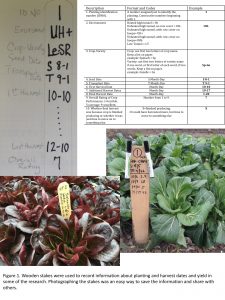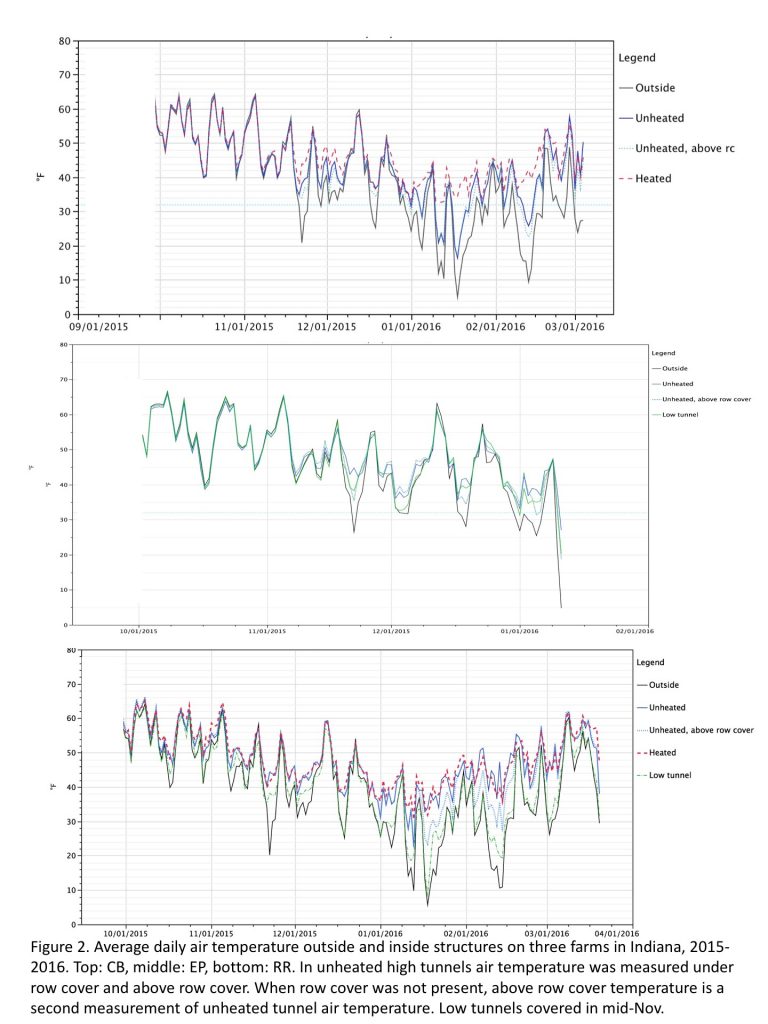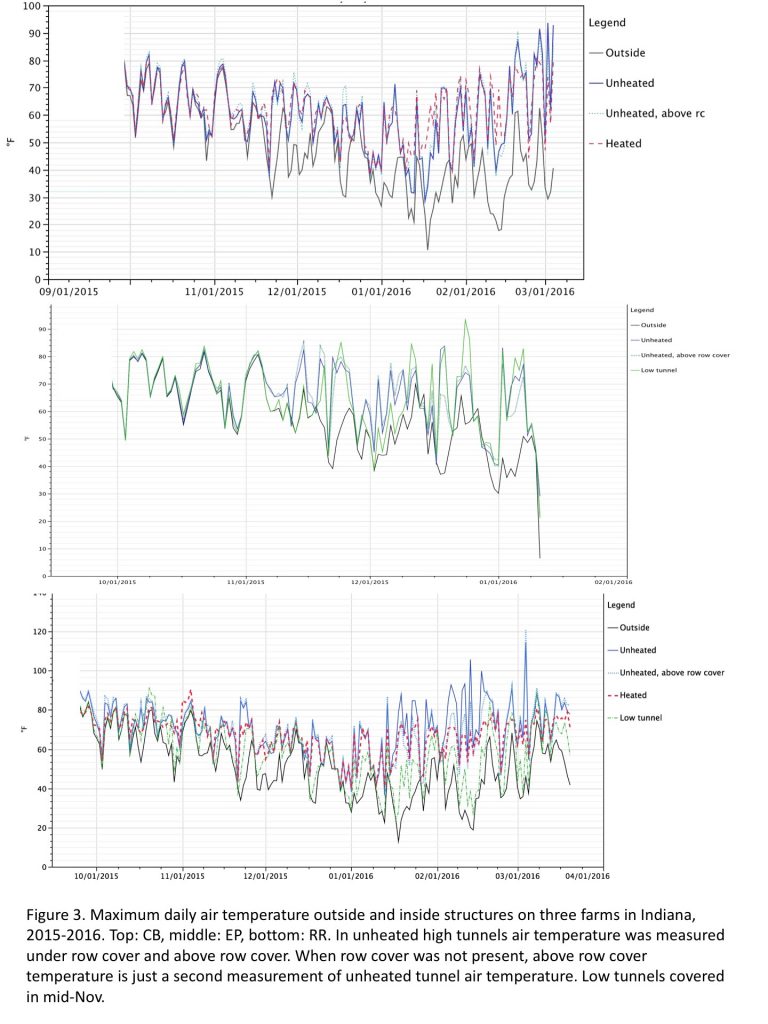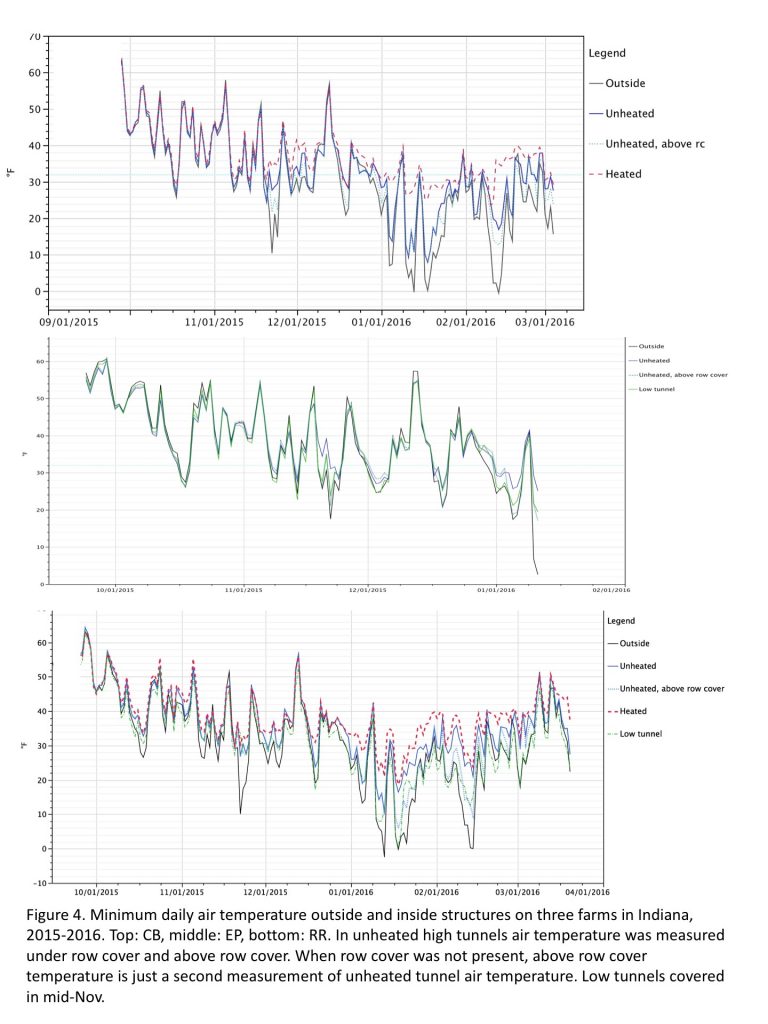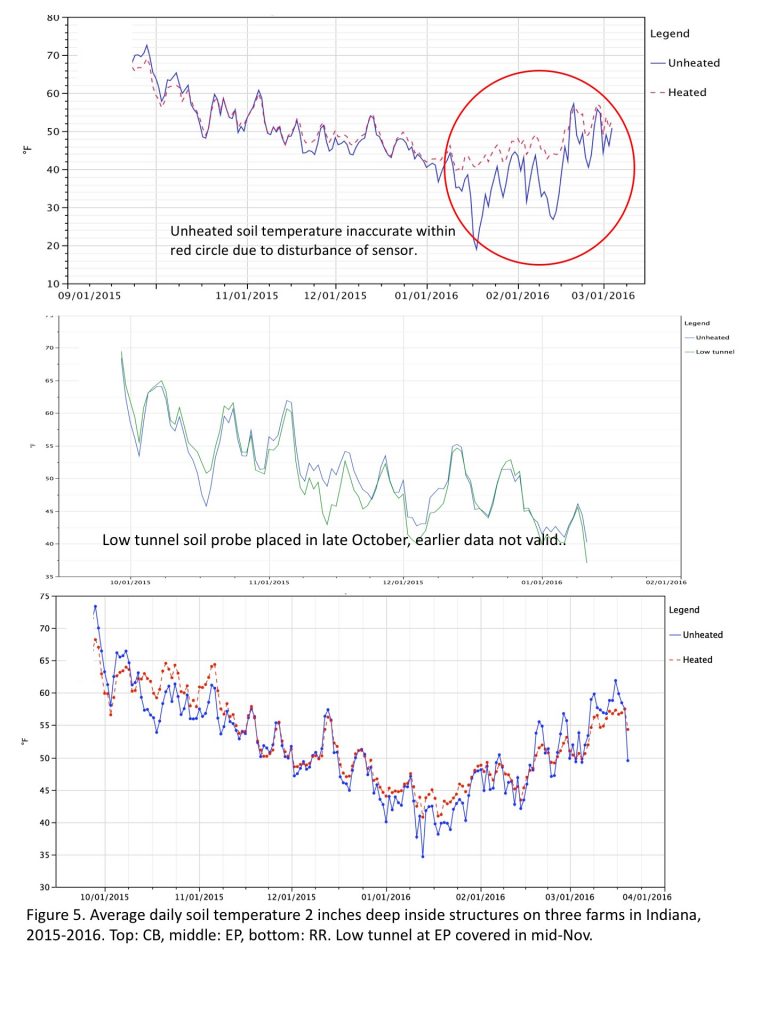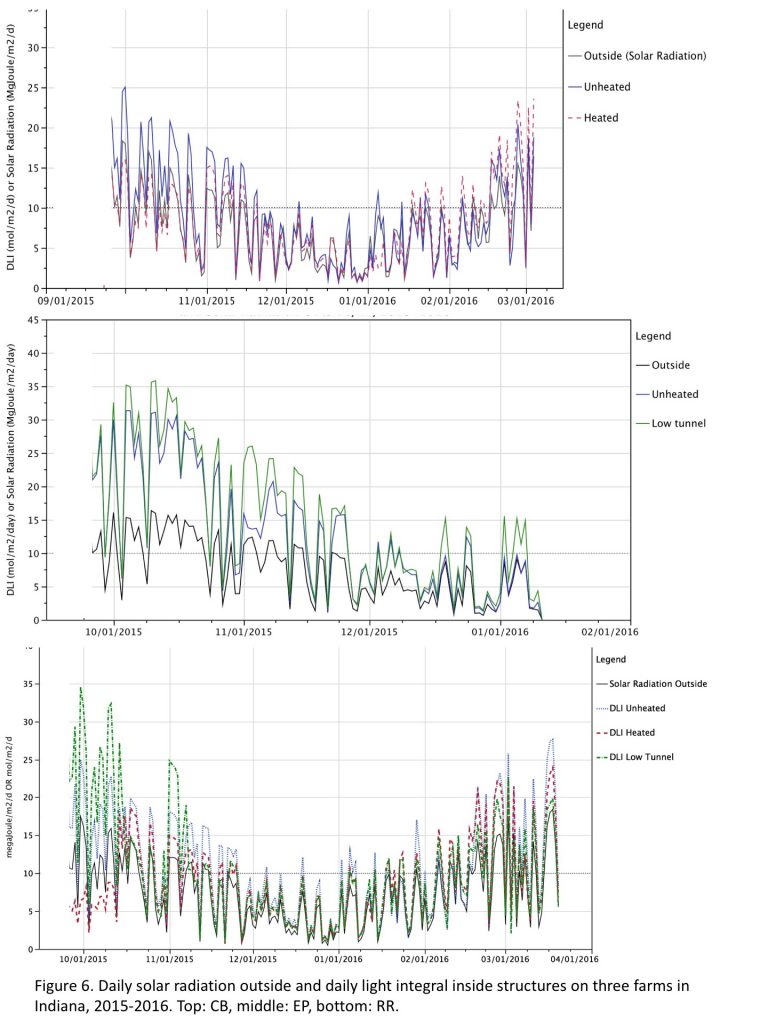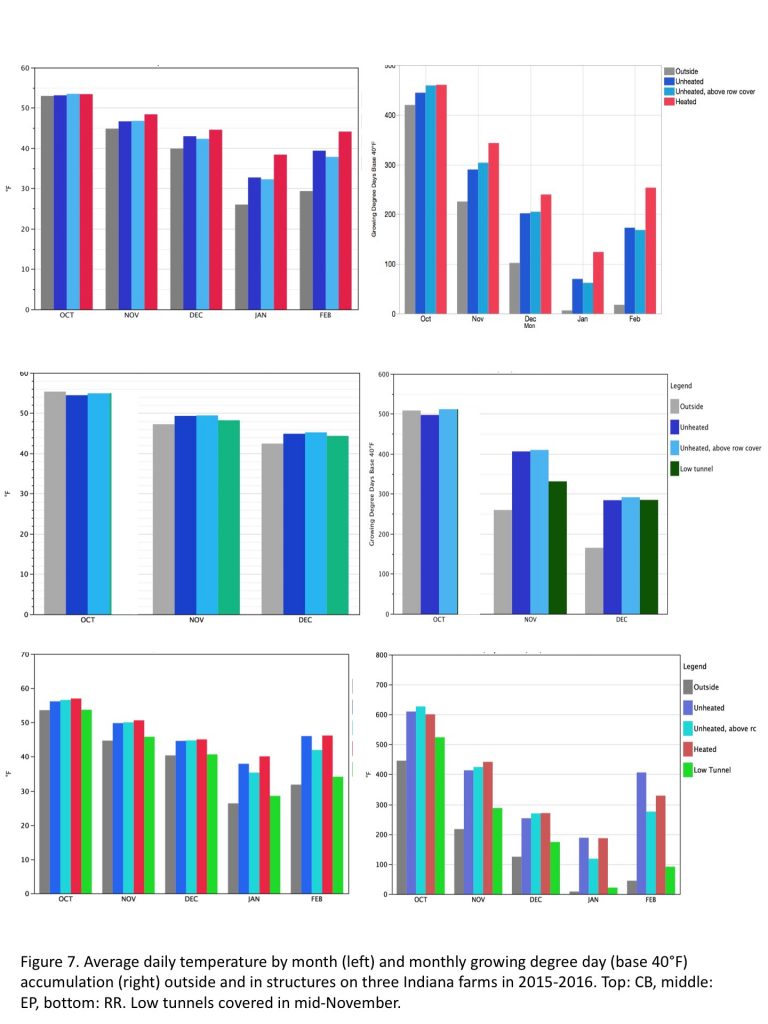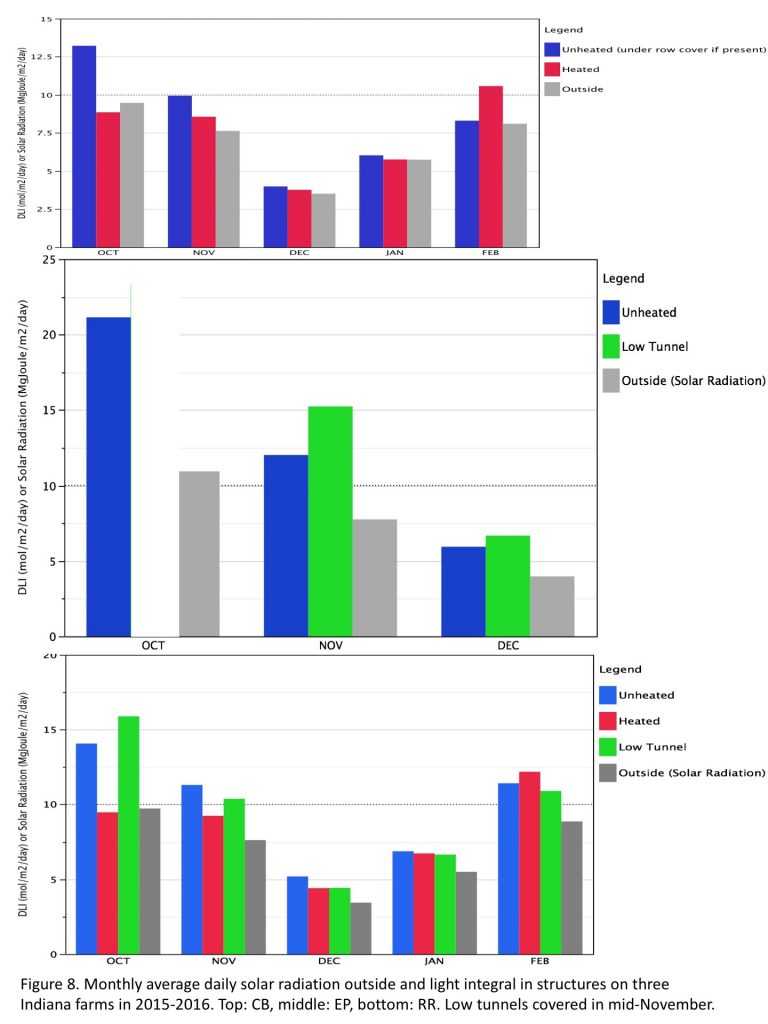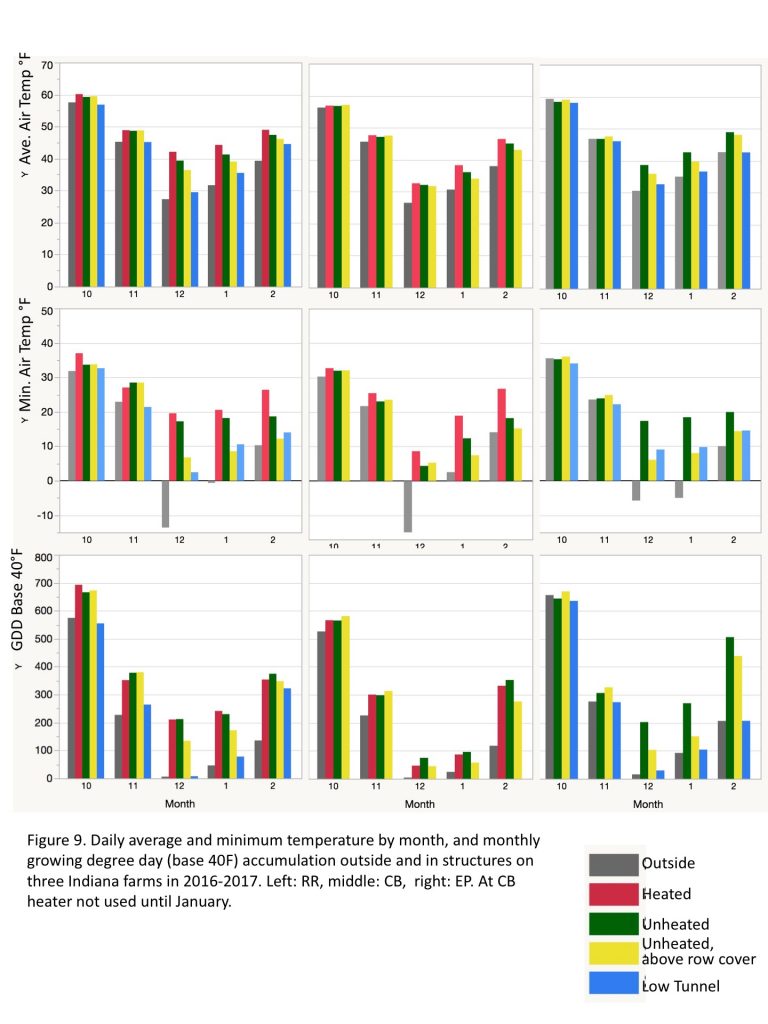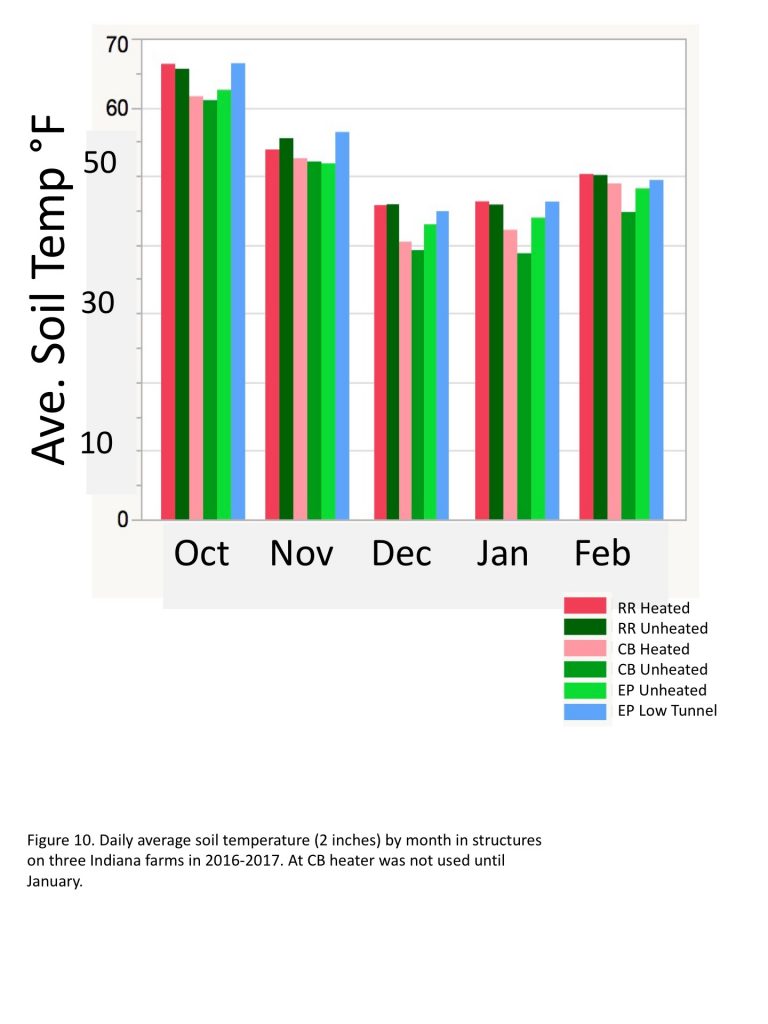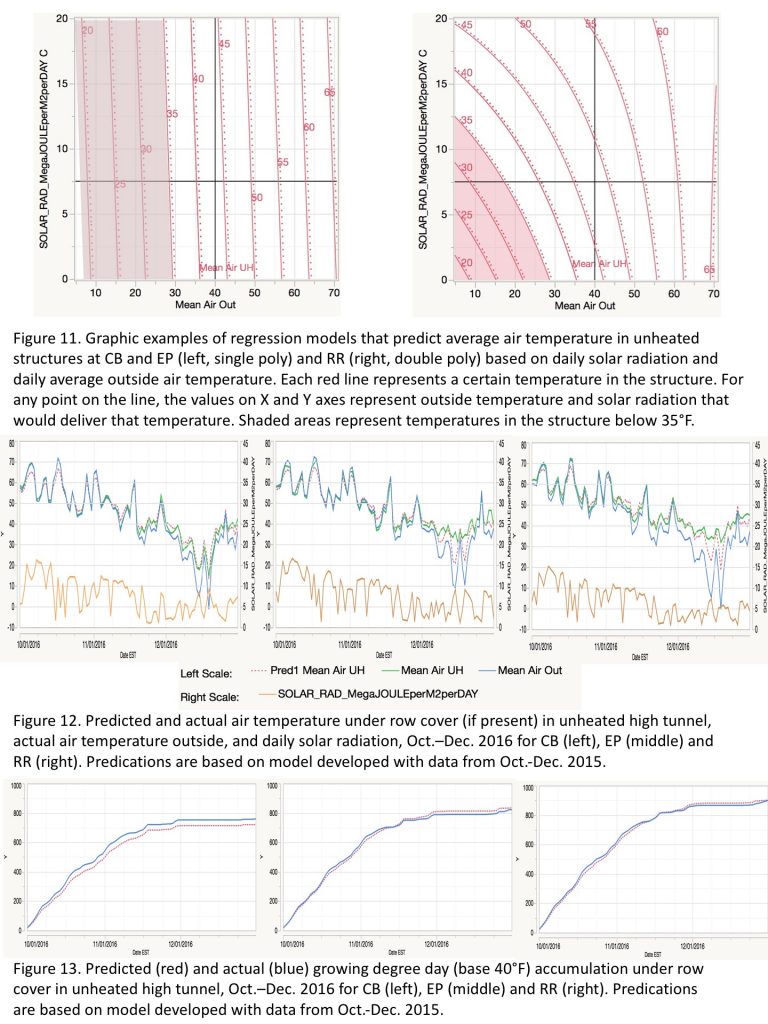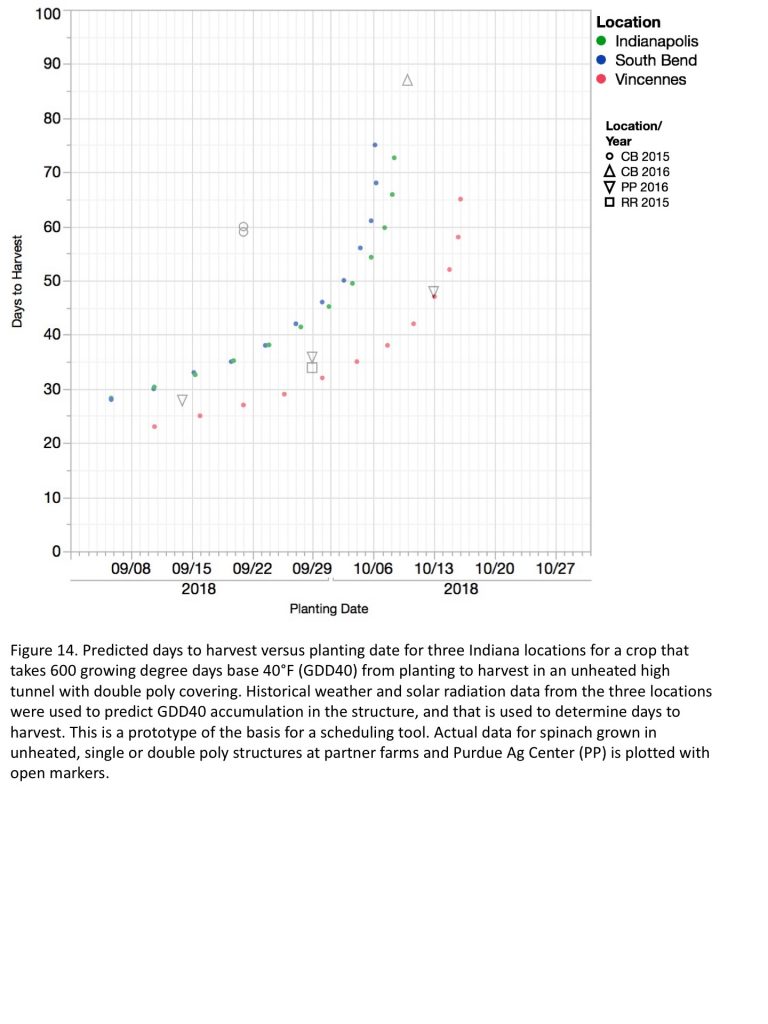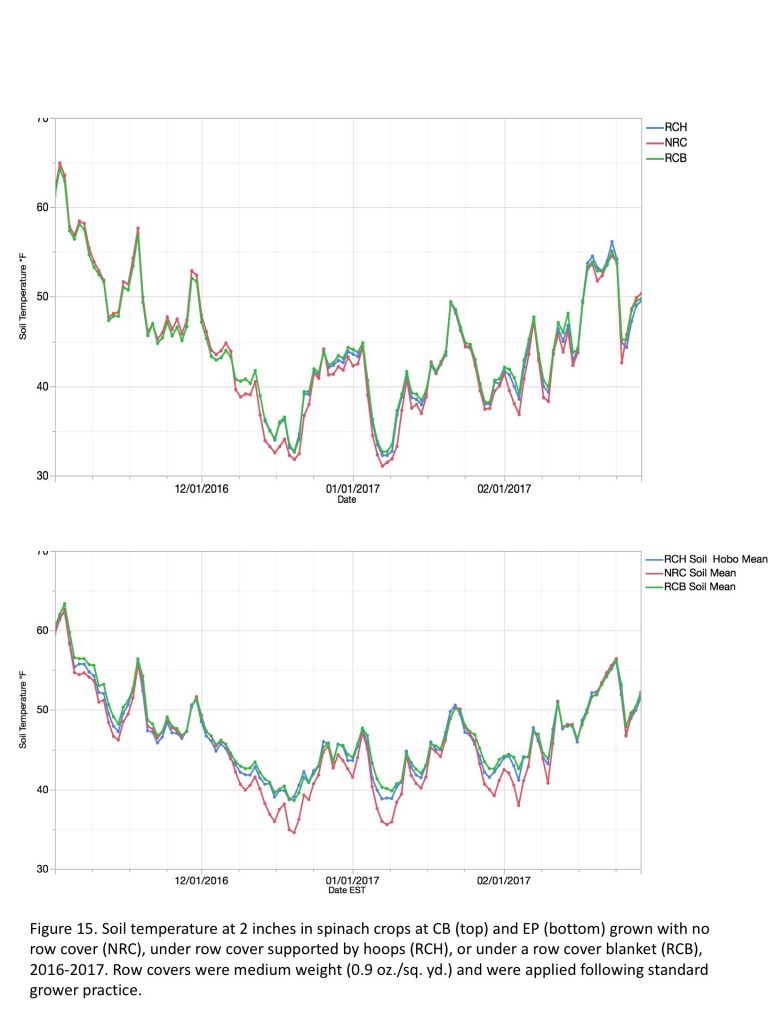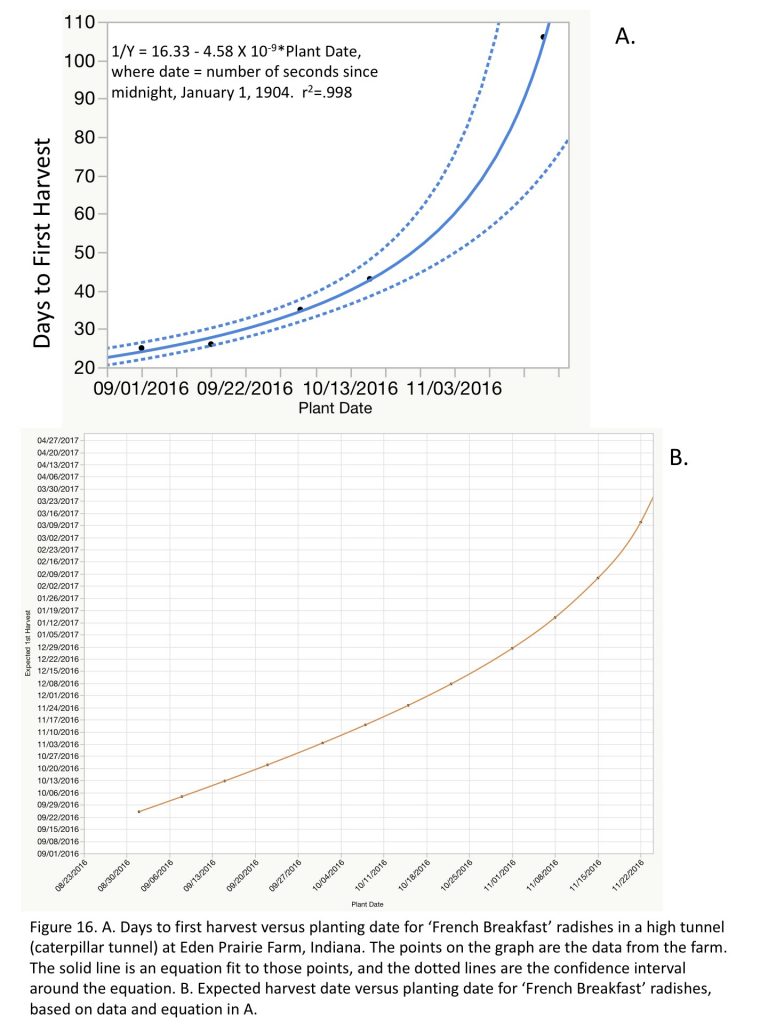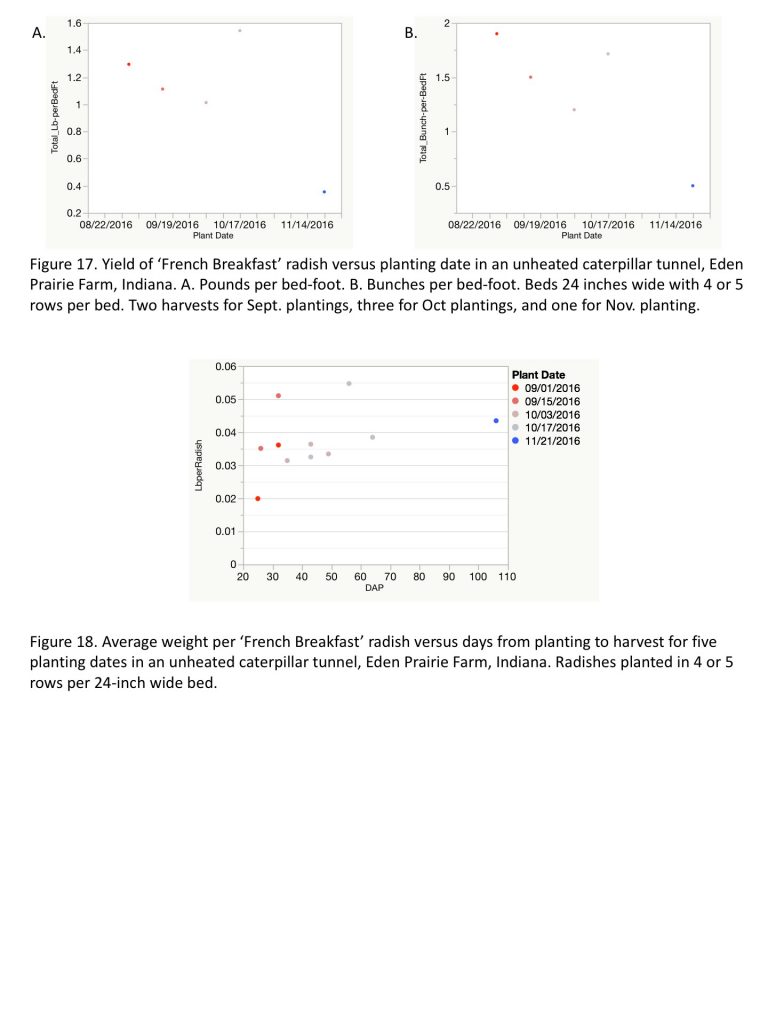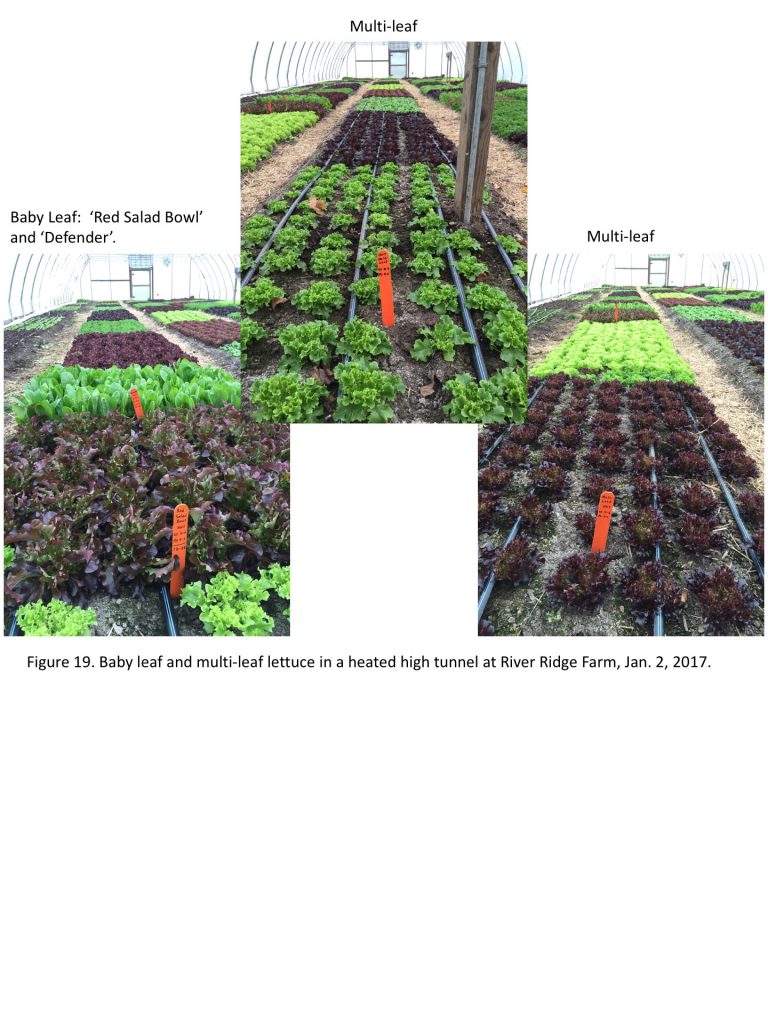Final report for ONC15-008
Project Information
In the North Central region winter production of vegetables in high and low tunnels contributes to sustainable agriculture by improving financial viability of farms and strengthening local food systems. One of the challenges of this relatively new production system is timing planting of crops to meet market demands and make good use of the space in the high tunnel. To address this problem this project was established to collect environmental information and cropping information from three established farms and use it to develop a scheduling tool and recommendations that would help farmers improve the match between when crops are ready for harvest and customers want to buy the crop.
In partnership with three Indiana farms the project installed dataloggers and sensors in high and low tunnels to measure solar radiation, photosynthetically active radiation, and air and soil temperatures, and to collect information on crop planting and harvest dates, and some yield information, during fall to spring growing seasons in 2015-2016 and 2016-2017.
The environmental data illustrated clearly the influence of solar radiation on temperatures in a high tunnel even on very cold days, how row covers affect light available to plants and temperature, and how using supplemental heat to maintain the minimum temperature above about 28°F, or to increase average daily temperature, leads to faster accumulation of growing degree days in the coldest months. Initial models suggest that if solar radiation and outdoor air temperature are known, average daily temperature inside a single or double-poly covered high tunnel can be predicted, and with that, a reasonable approximation of growing degree day accumulation inside the structure.
Planting and harvest records showed that earlier plantings in the fall generally had shorter times to first harvest. If planting was delayed enough in the fall, time to harvest lengthened significantly so that harvest did not occur until early the following spring. The date beyond which a planting wouldn't be ready until the next spring varied among crops and between structures, but generally was in mid-October to mid-November.
Educational resources were developed in two key areas: managing the environment in high tunnels for cool season production, and scheduling crops for cool season production. Resources included posters about the project, slide presentations at a variety of programs, a webinar, and a manuscript for an Extension bulletin. A short video and a second Extension bulletin are still under development.
As a result of the project farmers attending outreach events have learned about managing the environment and planting schedules for cool season crops in high tunnels. Farmers directly involved with the project have adopted new methods of using row covers, improved recordkeeping, reinforced awareness of the value of experimentation on the farm and have constructed new growing structures that incorporate more automation for managing the environment and heating systems.
The first objective was to compile and summarize information from partner farmers about their planting and harvest schedules. This provided the basis for identifying what crops to keep track of in the first year of the project. The second objective was to document planting and harvest dates, yield, and environmental conditions for selected cool season crops in unheated and minimally heated high tunnels and low tunnels. This was done in 2015-2016 and 2016-2017; with emphasis mainly on planting and harvest dates in 2016-2017. An additional objective in 2016-2017 was to compare the use of row cover supported on hoops, row cover used like a blanket, and no row cover. Once the data were collected the next objective was to create and deliver educational resources to help growers better manage the environment in high tunnels, and improve their planting schedule for winter crops in high tunnels.
Cooperators
Research
Environmental Monitoring in High Tunnels and Low Tunnels on Three Farms.
In 2015-2016 and 2016-2017 we collected environmental data on three partner farms as outlined in Tables 1 and 2.
Table 1. Farms and structures.
|
Farm |
Location |
Structure |
Size (Length X Width X Height, ft.) |
Covering |
Supplemental Heat |
|
Clay Bottom Farm (CB) |
Goshen, IN |
Heated high tunnel (Ht) |
90 X 30 X 14 |
Double poly |
yes |
|
|
|
Unheated high tunnel (UH) |
90 X 30 X 14 |
Single poly |
no |
|
Eden Prairie Farm (EP) |
Greenfield, IN |
Caterpillar tunnel (UH) |
50 X 12 X 7 |
Single poly |
no |
|
|
|
Low tunnel (LT) |
50 X 4 X 4 |
2015-2016: Single poly, 2016-2017: Row cover |
no |
|
River Ridge Farm (RR) |
Roann, IN |
Heated high tunnel (Ht) |
96 X 30 X 12 |
Double poly |
yes |
|
|
|
Unheated high tunnel (UH) |
96 X 30 X 12 |
Double poly |
no |
|
|
|
Low tunnel (LT) |
30 X 6 X 3 |
Row cover, poly when very cold |
no |
Table 2. Environmental Measurements
|
Measurement and Sensor Information |
Clay Bottom |
Eden Prairie |
River Ridge |
|||||||
|
|
Out-side |
Ht |
UH |
Out-side |
UH |
LT |
Out-side |
Ht |
UH |
LT |
|
Solar radiation, about 6 ft. Silicon pyranometer smart sensor, S-LIB-M003, Onset Computer Corp., Bourne, MA (OCC). |
X |
|
|
X |
|
|
X |
|
|
|
|
Air temperature, about 6 ft. 12-bit temperature smart sensor, S-TMB-M0xx, with Solar radiation shield RS3, OCC. |
X |
|
|
X |
|
|
X |
|
|
|
|
Air temperature, under row cover (if present) Temperature/RH smart sensor, S-THB-M00x, with Solar radiation shield, RS3, OCC |
|
X |
X |
|
X |
X |
|
X |
X |
X |
|
Relative humidity, under row cover (if present) Temperature/RH smart sensor, S-THB-M00x, with Solar radiation shield, RS3, OCC |
|
X |
X |
|
X |
X |
|
X |
X |
X |
|
Air temperature, above row cover (if present) 12-bit temperature smart sensor, S-TMB-M0xx, with Solar radiation shield RS3, OCC. |
|
|
X |
|
X |
|
|
|
X |
|
|
Soil temperature, 2 inches 12-bit temperature smart sensor, S-TMB-M0xx, with Solar radiation shield RS3, OCC. |
|
X |
X |
|
X |
X |
|
X |
X |
|
|
Soil moisture, 6 inches Soil moisture smart sensor, S-SMD-M005, OCC |
|
X |
X |
|
X |
|
|
X |
X |
|
|
Photosynthetically active radiation, under row cover (if present) PAR Smart Sensor, S-LIA-M003, OCC |
|
X |
X |
|
X |
X |
|
X |
X |
X |
At each farm, most sensors for environmental measurements were connected by wires to a RX3000 datalogger outfitted with a wifi transmitter (Onset Computer Corp., Bourne, MA). A wifi antenna (N150 wireless outdoor PoE access point, model TEW-715APO, TRENDnet, Inc., Torrance, CA) was connected to the internet router on each farm and located so that the RX 3000 datalogger could connect to it. Sensors logged measurements every 10 minutes and every hour data was transferred via wifi to the Hobolink website managed by Onset Computer Corp. Data was typically sent weekly from the Hobolink site to the project leader. Images of the logger and sensors are shown in the poster presented at the Indiana Small Farms Conference in 2016.
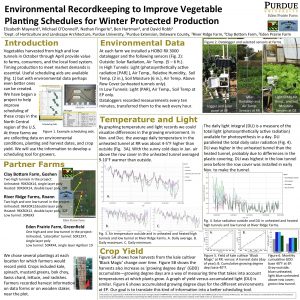
WatchDog 1650 dataloggers (Spectrum Technologies, Aurora, IL) with internal temperature and relative humidity sensors and external sensors including a LightScout Quantum Light Sensor for PAR and temperature sensors were used for some measurements. These logged data at 15-minute intervals and were downloaded manually. WatchDog B-series button temperature sensor/dataloggers set to record hourly were used for some soil temperature measurements and were downloaded manually.
Crop Planting and Harvest Dates and Yield
In 2015-2016 partner farmers recorded planting dates, harvest dates, and yield for selected crops grown using their standard practices. Farmers selected which crops to collect data on, but we made an effort to have information from kale and spinach from all three locations. Crops and typical plant spacings are provided in Table 3.
Table 3. Crops and typical spacings for 2015-2016 research.
|
Farm |
Crop |
Typical Row X In-row Spacing (inches) |
|
CB |
Bok Choy |
9 X 9 |
|
EP |
Braising Mix |
4 X 1 |
|
RR |
Braising Mix |
6 X fairly thick |
|
CB |
Kale |
9 x 9 |
|
EP |
Kale |
12 x 12 |
|
RR |
Kale |
12 X 12 |
|
CB |
Lettuce |
9 X 9 |
|
EP |
Lettuce |
8 X 8 |
|
RR |
Lettuce |
6 X 6 |
|
RR |
Mustard |
12 X 12 |
|
EP |
Radish |
4 X 1 |
|
CB |
Spinach |
5.5 X 5.5 |
|
EP |
Spinach |
8 X 1 |
|
RR |
Spinach |
6 X 3 |
|
CB |
Swiss Chard |
9 X 9 |
|
EP |
Swiss Chard |
12 X 16 |
|
RR |
Swiss Chard |
12 X 12 |
|
CB |
Tokyo Bekana |
9 X 9 |
Yield data were collected only when the crop was harvested for sale, and this did not always occur on a regular basis due to variations in market demand and farm schedules. As a result the information on yield did not consistently provide a good estimate of the full yield potential of the crop. For this reason, in 2016-2017 partner farms recorded planting and harvest dates for selected crops and kept yield information only for a few crops that were including in additional trials described below.
At some locations in 2015-2016 data were recorded on paper forms provided by project leader. At other locations, and at all locations in 2016-2017, data were recorded on wooden stakes set in the ground near each plot; one stake per plot (Fig. 1). Photographs of forms and stakes were periodically sent to project leader, and forms and stakes were delivered to project leader at end of the data collection period.
Spinach Row Cover Study
In 2016-2017 a study to compare using row cover with or without support hoops was conducted on the three partner farms. In unheated tunnels on each farm, three row cover treatments were used: 1. No row cover (NRC); 2. Row cover blanket on crop (RCB); 3. Row cover supported by hoops (RCH). Two replications (plots) of each treatment at each farm were arranged in a randomized complete block design. The row covers were medium weight, 0.9 oz. / sq. yd. Spinach was also grown in heated tunnels on two farms and in a low tunnel on one farm. The thermostats in heated tunnel were set around 25-30°F, but the heater at CB did not operate until January. Spinach was direct-seeded on beds 24-36 inches wide with rows spaced 4–6 inches apart. Stand count 2–3 weeks after seeding and harvest data were taken from a designated area about 4–5 sq. ft. in each treatment plot. Individual leaves of marketable size were harvested 2 to 7 times. Marketable yield per square foot and per plant were calculated for each plot. In March, 10 plants were selected from each plot and weighed. This provided an estimate of unharvested weight per plant. See Table 4 for details of planting and harvest dates. Images of the plots are shown in the poster presented at the Indiana Small Farms Conference in 2017.
Crops and Cover: Winter Growing in Central and Northern Indiana
Table 4. Spinach variety, dates of planting and harvest, and harvest area for row cover trial on three Indiana farms in 2016-2017.
|
Clay Bottom |
Eden Prairie |
River Ridge |
|
|
Variety |
Corvair |
Gazelle |
Gazelle |
|
Plant Date |
10/10 |
10/3 |
10/3 |
|
Harvest Dates and Area Harvested (sq. ft.) |
|||
|
Heated (HHT) |
12/22, 3/3 4.7 |
– |
12/5, 12/20, 1/2, 1/25, 2/8, 2/23, 3/7 5.0 |
|
Unheated (UH) |
12/22, 2/12, 3/9 4.7 |
11/15, 12/12, 1/18, 2/14 4.0 |
12/5, 12/20, 1/2, 1/25, 2/8, 2/23, 3/7 5.0 |
|
Low tunnel (LT) |
– |
11/15, 12/5, 2/6 5.3 |
– |
Air temperature at crop level and and soil temperature at 2 inches were recorded in or near most treatment plots for the spinach trial. At CB in the heated high tunnel the same sensors were used as in 2015-2016, except there was no soil moisture. The sensors were located in a bed of lettuce a short distance from the spinach trial. At CB and EP in the unheated high tunnel, wireless sensor tags (CAO Gadgets LLC, Irvine, CA) were used to measure air temperature in the trial plots, and the sensors used in 2015-2016 were located in another planting of spinach (CB), or in one of the spinach treatment plots (EP). The wireless tags were set to log temperatures every ten minutes and data was transmitted automatically to a wireless tag manager connected to an ethernet port on the farm's router, and from there to a cloud-based server. Soil temperatures in the spinach trial in the unheated tunnels at CB and EP (two treatments) were measured using WatchDog B-series button temperature sensor/dataloggers set to record hourly; the third treatment at EP had the soil temperature sensor from 2015-2016. In the low tunnel at EP the same sensors used in 2015-2016 were used. At RR in the heated high tunnel and low tunnel the same sensors were used as in 2015-2016. At RR in the unheated tunnel a WatchDog 1650 datalogger (Spectrum Technologies, Aurora, IL) with internal temperature and relative humidity sensors, and three external temperature sensors (two soil and one air) was used for two treatments, and the third treatment had the same sensors used in 2015-2016. Wireless tags and the external air temperature sensor attached to the WatchDog logger were shielded from solar radiation by home-made radiation shields described in Holden, Z.A., Klene, A.E., Keefe, R.F. and Moisen, G.G., 2013. Design and evaluation of an inexpensive radiation shield for monitoring surface air temperatures. Agricultural and Forest Meteorology, 180, pp.281-286.
Radish Planting Date Study
In 2016-2017 at EP a radish planting date study was conducted to understand how planting date influences days to harvest and yield. Radishes were seeded on 9/1, 9/15, 9/17, 10/3, 10/17, and 11/21 and harvested when they reached market maturity. Only radishes of marketable size and quality were harvested. Some planting dates were harvested a second or third time when smaller radishes reached marketable size. At harvests, yield as number of bunches, weight of a bunch, and number of radishes in a bunch were recorded. The variety was French Breakfast, from Johnny's Selected Seeds or Harris Moran. Bed length was 5 to 10 ft. per planting date and beds were 24 inches across.
Baby Leaf versus Multi-leaf Lettuce
In 2016-2017 River Ridge farm compared yield of baby leaf ('Red Salad Bowl' and 'Defender') and multi-leaf lettuce. Both were seeded in transplant trays on Oct. 6 and transplanted into a heated high tunnel at 6X6 in. spacing on Nov. 2. Baby leaf varieties had multiple plants in each transplant plug and multi-leaf varieties had just one plant per plug.
Environmental Monitoring in High Tunnels and Low Tunnels on Three Farms
Environmental records for 2015-2016 and 2016-2017 are summarized in Figs. 2 through 10.
Crop Planting and Harvest Dates and Yield
Crop planting and harvest dates from 2015-2016 and 2016-2017 are summarized in Table 5. The growing degree days and daily light integral accumulated from planting to harvest covered a wide range even within crop types (data not shown). Yield for the 2015-2016 season is presented in Table 6.. As mentioned in the methods section, harvests were determined in part by market requirements and so yield reported for some crops does not represent their full potential. Generally, yield decreased with later planting dates in the same environment.
| Table 5. Planting and harvest dates and number of harvests for crops in field, minimally heated and unheated high tunnels, and low tunnels. Data provided by four Indiana farms for the 2015-2016 and 2016-2017 growing seasons. | ||||||||||
| Farm | Crop | Variety | Environment | Plant Method \1 | Plant Date | Days to Harvest | Date of Harvest | No. of Harvests | ||
| First | Final | First | Final | |||||||
| EP | Arugula | Astro | Field | DS | 9/13/16 | 30 | 30 | 10/13/16 | 10/13/16 | 1 |
| EP | Arugula | Astro | Field | DS | 9/15/16 | 40 | 40 | 10/25/16 | 10/25/16 | 1 |
| CB | Beet | Beet | Field | TR-18 | 7/15/16 | 109 | 109 | 11/1/16 | 11/1/16 | 1 |
| CB | Greens | Mixed, baby | Field | TR-12 | 8/9/16 | 13 | 60 | 8/22/16 | 10/8/16 | 8 |
| CB | Greens | Mixed, baby | Field | TR-12 | 8/9/16 | 13 | 30 | 8/22/16 | 9/8/16 | 4 |
| CB | Greens | Mizuna | Field | DS | 9/1/16 | 33 | 53 | 10/4/16 | 10/24/16 | 3 |
| CB | Kale | Red Russian | Field | DS | 9/8/16 | 47 | 61 | 10/25/16 | 11/8/16 | 2 |
| CB | Kale | Red Russian | Field | DS | 9/14/16 | 37 | 52 | 10/21/16 | 11/5/16 | 3 |
| CB | Kale | Red Russian | Field | DS | 9/14/16 | 48 | 62 | 11/1/16 | 11/15/16 | 3 |
| CB | Lettuce | Salanova | Field | TR-19 | 8/16/16 | 30 | 30 | 9/15/16 | 9/15/16 | 1 |
| CB | Radish | Patricia | Field | DS | 8/4/16 | 35 | 35 | 9/8/16 | 9/8/16 | 1 |
| EP | Radish | French Breakfast | Field | DS | 9/4/16 | 27 | 27 | 10/1/16 | 10/1/16 | 1 |
| EP | Radish | Karaine, Green Meat, Bora King | Field | DS | 9/4/16 | 41 | 64 | 10/15/16 | 11/7/16 | 2 |
| CB | Spinach | Gazelle | Field | DS | 8/25/16 | 56 | 71 | 10/20/16 | 11/4/16 | 2 |
| PH | Spinach | Space | Field | DS | 9/1/16 | 29 | 36 | 9/30/16 | 10/7/16 | 2 |
| CB | Spinach | Gazelle | Field | TR-10 | 9/1/16 | 51 | 59 | 10/22/16 | 10/30/16 | 2 |
| CB | Spinach | Gazelle | Field | TR-14 | 9/15/16 | 44 | 68 | 10/29/16 | 11/22/16 | 3 |
| CB | Bok Choy | Joi Choi | Heated | TR-21 | 8/26/15 | 37 | 176 | 10/2/15 | 2/18/16 | 9 |
| CB | Bok Choy | Carlton | Heated | DS | 11/15/16 | 105 | 114 | 2/28/17 | 3/9/17 | 3 |
| CB | Bok Choy | Koji | Heated | DS | 11/15/16 | 106 | 105 | 3/1/17 | 2/28/17 | 2 |
| CB | Greens | Mizuna | Heated | DS | 10/10/16 | 38 | 55 | 11/17/16 | 12/4/16 | 3 |
| RR | Greens | Braising mix \2 | Heated | DS | 10/21/15 | 56 | 62 | 12/16/15 | 12/22/15 | 3 |
| CB | Kale | Lacinato | Heated | TR-25 | 8/26/15 | 79 | 169 | 11/13/15 | 2/11/16 | 8 |
| CB | Kale | Red Russian Select | Heated | TR-23 | 8/26/15 | 31 | 134 | 9/26/15 | 1/7/16 | 9 |
| RR | Kale | Black Magic | Heated | TR-? | 9/1/15 | 44 | 20 | 10/15/15 | 9/21/15 | 20 |
| RR | Kale | Red Russian Select | Heated | TR-? | 9/1/15 | 44 | 183 | 10/15/15 | 3/2/16 | 19 |
| CB | Kale | Red Russian | Heated | DS | 10/10/16 | 125 | 138 | 2/12/17 | 2/25/17 | 2 |
| CB | Kale | Red Russian | Heated | DS | 10/17/16 | 118 | 136 | 2/12/17 | 3/2/17 | 3 |
| CB | Kale | Red Russian | Heated | DS | 11/8/16 | 112 | 121 | 2/28/17 | 3/9/17 | 3 |
| CB | Lettuce | Salad Bowl | Heated | DS | 10/10/16 | 111 | 140 | 1/29/17 | 2/27/17 | 4 |
| CB | Lettuce | Defender | Heated | DS | 10/10/16 | 114 | 143 | 2/1/17 | 3/2/17 | 3 |
| RR | Lettuce | Red Salad Bowl | Heated | TR-20 | 10/12/16 | 26 | 71 | 11/7/16 | 12/22/16 | 3 |
| RR | Lettuce | Defender | Heated | TR-20 | 10/12/16 | 26 | 71 | 11/7/16 | 12/22/16 | 3 |
| CB | Lettuce | Defender | Heated | DS | 10/17/16 | 107 | 135 | 2/1/17 | 3/1/17 | 3 |
| CB | Lettuce | Red Salad Bowl | Heated | DS | 10/17/16 | 109 | 127 | 2/3/17 | 2/21/17 | 4 |
| RR | Lettuce | Red Salad Bowl | Heated | TR-27 | 10/19/16 | 49 | 49 | 12/7/16 | 12/7/16 | 1 |
| CB | Lettuce | Defender | Heated | DS | 10/21/16 | 127 | 139 | 2/25/17 | 3/9/17 | 2 |
| RR | Lettuce | Defender | Heated | TR-20 | 10/26/16 | 49 | 49 | 12/14/16 | 12/14/16 | 1 |
| RR | Lettuce | Red Salad Bowl | Heated | TR-20 | 10/26/16 | 49 | 49 | 12/14/16 | 12/14/16 | 1 |
| RR | Lettuce | Multileaf | Heated | TR-27 | 10/26/16 | 55 | 119 | 12/20/16 | 2/22/17 | 2 |
| RR | Lettuce | Multileaf | Heated | TR-30 | 10/1/15 | 67 | 83 | 12/7/15 | 12/23/15 | 8 |
| CB | Lettuce | Red Salad Bowl | Heated | DS | 10/31/16 | 112 | 126 | 2/20/17 | 3/6/17 | 3 |
| CB | Lettuce | Defender | Heated | DS | 10/31/16 | 122 | 129 | 3/2/17 | 3/9/17 | 2 |
| RR | Lettuce | Red Salad Bowl | Heated | TR-27 | 11/2/16 | 50 | 50 | 12/22/16 | 12/22/16 | 1 |
| RR | Lettuce | Defender | Heated | TR-27 | 11/2/16 | 50 | 50 | 12/22/16 | 12/22/16 | 1 |
| RR | Lettuce | Multileaf | Heated | TR-27 | 11/2/16 | 54 | 120 | 12/26/16 | 3/2/17 | 2 |
| CB | Lettuce | Red Salad Bowl | Heated | DS | 11/8/16 | 104 | 121 | 2/20/17 | 3/9/17 | 3 |
| CB | Lettuce | Defender | Heated | DS | 11/8/16 | 113 | 121 | 3/1/17 | 3/9/17 | 2 |
| CB | Lettuce | Red Salad Bowl | Heated | DS | 11/12/16 | 95 | 117 | 2/15/17 | 3/9/17 | 3 |
| CB | Lettuce | Defender | Heated | DS | 11/12/16 | 110 | 117 | 3/2/17 | 3/9/17 | 2 |
| RR | Mustard | Mix \3 | Heated | TR-30 | 10/1/15 | 7 | 144 | 10/8/15 | 2/22/16 | 13 |
| CB | Spinach | Gazelle | Heated | DS | 10/21/16 | 103 | 138 | 2/1/17 | 3/8/17 | 2 |
| CB | Spinach | Corvair | Heated | DS | 10/21/16 | 103 | 131 | 2/1/17 | 3/1/17 | 2 |
| CB | Spinach | Gazelle | Heated | DS | 10/31/16 | 121 | 128 | 3/1/17 | 3/8/17 | 2 |
| CB | Spinach | Corvair | Heated | DS | 10/31/16 | 129 | 129 | 3/9/17 | 3/9/17 | 1 |
| CB | Spinach | Gazelle | Heated | DS | 11/8/16 | 121 | 121 | 3/9/17 | 3/9/17 | 1 |
| CB | Spinach | Corvair | Heated | DS | 11/8/16 | 121 | 121 | 3/9/17 | 3/9/17 | 1 |
| CB | Spinach | Woodpecker | Heated | DS | 11/15/16 | 114 | 114 | 3/9/17 | 3/9/17 | 1 |
| CB | Swiss Chard | Swiss Chard | Heated | TR-25 | 8/26/15 | 30 | 169 | 9/25/15 | 2/11/16 | 11 |
| RR | Swiss Chard | Bright Lights, Silverado | Heated | TR-? | 9/1/15 | 48 | 184 | 10/19/15 | 3/3/16 | 19 |
| CB | Tatsoi | Tatsoi | Heated | DS | 10/10/16 | 128 | 142 | 2/15/17 | 3/1/17 | 3 |
| CB | Tatsoi | Tatsoi | Heated | DS | 10/17/16 | 127 | 135 | 2/21/17 | 3/1/17 | 2 |
| CB | Tokyo Bekana | Tokyo Bekana | Heated | TR-21 | 8/26/15 | 31 | 134 | 9/26/15 | 1/7/16 | 7 |
| RR | Greens | Braising mix | Low Tunnel | DS | 9/1/15 | 24 | 36 | 9/25/15 | 10/7/15 | 5 |
| RR | Greens | Braising mix | Low Tunnel | DS | 9/15/15 | 30 | 36 | 10/15/15 | 10/21/15 | 2 |
| RR | Greens | Braising mix | Low Tunnel | DS | 9/22/15 | 30 | 30 | 10/22/15 | 10/22/15 | 1 |
| RR | Greens | Braising mix | Low Tunnel | DS | 9/29/15 | 31 | 37 | 10/30/15 | 11/5/15 | 2 |
| EP | Spinach | Kookaburra | Low Tunnel | DS | 8/21/15 | 49 | 200 | 10/9/15 | 3/8/16 | 8 |
| RR | Spinach | Kookaburra | Low Tunnel | DS | 9/15/15 | 34 | 50 | 10/19/15 | 11/4/15 | 3 |
| RR | Spinach | Kookaburra | Low Tunnel | DS | 9/29/15 | 36 | 52 | 11/4/15 | 11/20/15 | 3 |
| PH | Arugula | Astro | Unheated | DS | 9/18/16 | 38 | 89 | 10/26/16 | 12/16/16 | 6 |
| PH | Greens | Elegance Mix (JSS) | Unheated | DS | 9/18/16 | 31 | 89 | 10/19/16 | 12/16/16 | 4 |
| EP | Greens | Braising Mix (JSS) | Unheated | DS | 8/21/15 | 52 | 114 | 10/12/15 | 12/13/15 | 6 |
| PH | Greens | Braising Mix (JSS) | Unheated | DS | 10/1/16 | 39 | 76 | 11/9/16 | 12/16/16 | 2 |
| EP | Greens | Mix | Unheated | DS | 10/6/16 | 40 | 88 | 11/15/16 | 1/2/17 | 3 |
| RR | Greens | Braising mix | Unheated | DS | 10/7/15 | 21 | 23 | 10/28/15 | 10/30/15 | 2 |
| CB | Greens | Mizuna | Unheated | DS | 11/8/16 | 99 | 121 | 2/15/17 | 3/9/17 | 3 |
| RR | Greens | Braising mix | Unheated | DS | 10/14/15 | 28 | 36 | 11/11/15 | 11/19/15 | 3 |
| RR | Greens | Braising mix | Unheated | DS | 10/21/15 | 29 | 29 | 11/19/15 | 11/19/15 | 1 |
| EP | Greens | Braising Mix (JSS) | Unheated | DS | 10/25/15 | 74 | 142 | 1/7/16 | 3/15/16 | 3 |
| RR | Greens | Braising mix | Unheated | DS | 10/28/15 | 27 | 42 | 11/24/15 | 12/9/15 | 6 |
| EP | Kale | Tuscano | Unheated | TR-48 | 9/1/15 | 38 | 188 | 10/9/15 | 3/7/16 | 8 |
| EP | Kale | Red Russian Select | Unheated | TR-39 | 9/15/15 | 24 | 168 | 10/9/15 | 3/1/16 | 6 |
| PH | Lettuce | Salanova | Unheated | TR-41 | 9/11/16 | 45 | 71 | 10/26/16 | 11/21/16 | 5 |
| RR | Lettuce | Salanova | Unheated | TR-28 | 9/14/16 | 27 | 64 | 10/11/16 | 11/17/16 | 2 |
| CB | Lettuce | MultiGreen 3 | Unheated | TR-23 | 8/24/15 | 44 | 186 | 10/7/15 | 2/26/16 | 3 |
| CB | Lettuce | Salanova Red | Unheated | TR-23 | 8/24/15 | 44 | 186 | 10/7/15 | 2/26/16 | 4 |
| RR | Lettuce | Salanova | Unheated | TR-28 | 9/28/16 | 37 | 37 | 11/4/16 | 11/4/16 | 1 |
| RR | Lettuce | Salanova | Unheated | TR-28 | 10/5/16 | 34 | 34 | 11/8/16 | 11/8/16 | 1 |
| RR | Lettuce | Multileaf | Unheated | TR-27 | 10/12/16 | 56 | 56 | 12/7/16 | 12/7/16 | 1 |
| RR | Lettuce | Multileaf | Unheated | TR-31 | 9/15/15 | 35 | 63 | 10/20/15 | 11/17/15 | 6 |
| EP | Lettuce | Multileaf | Unheated | TR-31 | 9/18/15 | 10 | 10 | 9/28/15 | 9/28/15 | 1 |
| CB | Lettuce | MultiGreen 3 | Unheated | TR-27 | 9/20/15 | 59 | 159 | 11/18/15 | 2/26/16 | 3 |
| CB | Lettuce | Salanova Red | Unheated | TR-27 | 9/20/15 | 71 | 159 | 11/30/15 | 2/26/16 | 2 |
| RR | Lettuce | Multileaf | Unheated | TR-27 | 10/19/16 | 62 | 62 | 12/20/16 | 12/20/16 | 1 |
| EP | Lettuce | Multileaf | Unheated | TR-31 | 10/2/15 | 66 | 66 | 12/7/15 | 12/7/15 | 1 |
| EP | Lettuce | Multileaf | Unheated | TR-29 | 10/15/15 | 85 | 85 | 1/8/16 | 1/8/16 | 1 |
| RR | Mesclun | Mesclun | Unheated | DS | 9/28/16 | 22 | 22 | 10/20/16 | 10/20/16 | 1 |
| RR | Mesclun | Mesclun | Unheated | DS | 10/5/16 | 28 | 28 | 11/2/16 | 11/2/16 | 1 |
| RR | Mesclun | Mesclun | Unheated | DS | 10/12/16 | 27 | 27 | 11/8/16 | 11/8/16 | 1 |
| EP | Radish | Red Meat | Unheated | DS | 8/6/16 | 78 | 78 | 10/23/16 | 10/23/16 | 1 |
| EP | Radish | French Breakfast | Unheated | DS | 9/1/16 | 25 | 32 | 9/26/16 | 10/3/16 | 2 |
| EP | Radish | French Breakfast | Unheated | DS | 9/1/16 | 25 | 32 | 9/26/16 | 10/3/16 | 2 |
| EP | Radish | French Breakfast | Unheated | DS | 9/15/16 | 26 | 32 | 10/11/16 | 10/17/16 | 2 |
| EP | Radish | French Breakfast | Unheated | DS | 10/3/16 | 35 | 49 | 11/7/16 | 11/21/16 | 3 |
| EP | Radish | French Breakfast | Unheated | DS | 10/17/16 | 43 | 64 | 11/29/16 | 12/20/16 | 3 |
| EP | Radish | French Breakfast | Unheated | DS | 11/21/16 | 106 | 106 | 3/7/17 | 3/7/17 | 1 |
| EP | Radish | French Breakfast | Unheated | DS | 10/28/15 | 71 | 71 | 1/7/16 | 1/7/16 | 1 |
| CB | Spinach | Corvair | Unheated | DS | 10/10/16 | 87 | 150 | 1/5/17 | 3/9/17 | 3 |
| CB | Spinach | Gazelle | Unheated | DS | 9/21/15 | 59 | 167 | 11/19/15 | 3/6/16 | 4 |
| CB | Spinach | Reflect | Unheated | DS | 9/21/15 | 60 | 167 | 11/20/15 | 3/6/16 | 3 |
| RR | Spinach | Kookaburra | Unheated | DS | 9/29/15 | 34 | 148 | 11/2/15 | 2/24/16 | 18 |
| PH | Swiss Chard | Swiss Chard | Unheated | TR-35 | 9/5/16 | 57 | 102 | 11/1/16 | 12/16/16 | 3 |
| EP | Swiss Chard | Bright Lights | Unheated | TR-40 | 9/15/15 | 24 | 115 | 10/9/15 | 1/8/16 | 7 |
| \1 Plant method: DS=direct seed; TR=transplants; number after TR is the number of days from seeding to transplanting. | ||||||||||
| \2 Braising mix at RR included separate blocks of the following varieties: Mizuna, Dark Purple Mizuna, Red Rain, Yukina Savoy, Tokyo Bekana, Golden Frills, Ruby Streaks (all from Johnny's Selected Seeds), Lime Streaks (from Harris). | ||||||||||
| \3 Mustard varieties included separate blocks of Red Giant, Green Wave, Spicy Green, and Dragon Tongue. | ||||||||||
| Table 6. Number of harvests and yield for late aummer and fall planted crops in minimally heated and unheated high tunnels, and low tunnels. Data provided by three Indiana farms for the 2015-2016 growing season. | |||||||
| Farm | Crop | Crop/Variety | Typical Row X In-row Spacing (inches) | Location | Seed or Transplant Date | Number of Harvests | Lb. Mkt. per Sq. Ft. |
| CB | Bok Choy | Joi Choi | 9 X 9 | Heated | 8/26/15 | 9 | 2.18 |
| RR | Braising Mix | Mix, see notes\1 | 6 X fairly thick | Heated | 10/21/15 | 3 | 0.31 |
| RR | Braising Mix | Mix, see notes | 6 X fairly thick | Low Tunnel | 9/1/15 | 5 | 0.23 |
| RR | Braising Mix | Mix, see notes | 6 X fairly thick | Low Tunnel | 9/15/15 | 2 | 0.24 |
| RR | Braising Mix | Mix, see notes | 6 X fairly thick | Low Tunnel | 9/22/15 | 1 | 0.25 |
| RR | Braising Mix | Mix, see notes | 6 X fairly thick | Low Tunnel | 9/29/15 | 2 | 0.29 |
| EP | Braising Mix | Premix from JSS \2 | 4 X 1 | Unheated | 8/21/15 | 6 | 0.38 |
| RR | Braising Mix | Mix, see notes | 6 X fairly thick | Unheated | 10/7/15 | 2 | 0.24 |
| RR | Braising Mix | Mix, see notes | 6 X fairly thick | Unheated | 10/14/15 | 3 | 0.20 |
| RR | Braising Mix | Mix, see notes | 6 X fairly thick | Unheated | 10/21/15 | 1 | 0.15 |
| EP | Braising Mix | Premix from JSS | 4 X 1 | Unheated | 10/25/15 | 3 | 0.12 |
| RR | Braising Mix | Mix, see notes | 6 X fairly thick | Unheated | 10/28/15 | 6 | 0.23 |
| RR | Kale | Black Magic | 12 X 12 | Heated | 9/1/15 | 20 | 0.47 |
| CB | Kale | Lacinato | 9 x 9 | Heated | 8/26/15 | 8 | 1.31 |
| EP | Kale | Tuscano | 12 x 12 | Unheated | 9/1/15 | 8 | 0.36 |
| CB | Kale | Red Russian Select | 9 X 9 | Heated | 8/26/15 | 9 | 0.52 |
| RR | Kale | Red Russian Select | 12 x 12 | Heated | 9/1/15 | 19 | 0.39 |
| EP | Kale | Red Russian Select | 12 x 12 | Unheated | 9/15/15 | 6 | 0.48 |
| RR | Lettuce | Multileaf | 6 X 6 | Heated | 10/1/15 | 8 | 0.49 |
| CB | Lettuce | MultiGreen 3 | 9 X 9 | Unheated | 8/24/15 | 3 | 0.76 |
| CB | Lettuce | MultiGreen 3 | 9 X 9 | Unheated | 9/20/15 | 3 | 0.27 |
| RR | Lettuce | Multileaf | 6 X 6 | Unheated | 9/15/15 | 6 | 0.44 |
| EP | Lettuce | Multileaf | 8 X 8 | Unheated | 9/18/15 | 1 | 0.13 |
| EP | Lettuce | Multileaf | 8 X 8 | Unheated | 10/2/15 | 1 | 0.11 |
| EP | Lettuce | Multileaf | 8 X 8 | Unheated | 10/15/15 | 1 | 0.02 |
| CB | Lettuce | Salanova Red | 9 X 9 | Unheated | 8/24/15 | 4 | 0.20 |
| CB | Lettuce | Salanova Red | 9 X 9 | Unheated | 9/20/15 | 2 | 0.09 |
| RR | Mustard | Mix, see notes\3 | 12 X 12 | Heated | 10/1/15 | 13 | 0.81 |
| EP | Radish | French Breakfast | 4 X 1 | Unheated | 10/28/15 | 1 | 0.14 |
| EP | Spinach | Kookaburra | 8 X 1 | Low Tunnel | 8/21/15 | 8 | 0.25 |
| RR | Spinach | Kookaburra | 6 X 3 | Low Tunnel | 9/15/15 | 3 | 0.17 |
| RR | Spinach | Kookaburra | 6 X 3 | Low Tunnel | 9/29/15 | 3 | 0.17 |
| RR | Spinach | Kookaburra | 6 X 3 | Unheated | 9/29/15 | 18 | 0.78 |
| CB | Spinach | Gazelle | 5.5 X 5.5 | Unheated | 9/21/15 | 4 | 0.28 |
| CB | Spinach | Reflect | 5.5 x 5.5 | Unheated | 9/21/15 | 3 | 0.37 |
| RR | Swiss Chard | Bright Lights, Silverado | 12 X 12 | Heated | 9/1/15 | 19 | 0.29 |
| CB | Swiss Chard | Swiss Chard | 9 X 9 | Heated | 8/26/15 | 11 | 0.80 |
| EP | Swiss Chard | Bright Lights | 12 X 16 | Unheated | 9/15/15 | 7 | 0.45 |
| CB | Tokyo Bekana | Tokyo Bekana | 9 X 9 | Heated | 8/26/15 | 7 | 0.76 |
| \1 Braising mix varieties: Separate blocks of the following: Mizuna, Dark Purple Mizuna, Red Rain, Yukina Savoy, Tokyo Bekana, Golden Frills, Ruby Streaks (all from JSS), Lime Streaks (from Harris). | |||||||
| \2 JSS = Johnny's Selected Seeds | |||||||
| \3 Mustard varieties: Separate blocks of the following: Red Giant, Green Wave, Spicy Green, Dragon Tongue. | |||||||
Mathematical relationships between daily solar radiation and average daily temperature outside, and average daily temperature inside an unheated high tunnel were identified and are illustrated in Figure 11. A comparison of the air temperature in unheated tunnels predicted by the relationship and the actual temperatures measured in Oct. - Dec. 2016 is shown in Fig. 12. The predicted and actual accumulation of growing degree days in these structures is illustrated in Fig. 13.
We constructed a graph to illustrate how these results could be used to create the basis for a scheduling tool, assuming a consistent relationship between growing degree days (GDD), daily light integral (DLI) and harvest maturity can be described (Fig. 14).
For three locations in Indiana we used historical records of typical daily solar radiation and normal average daily temperature (obtained from online sources) to predict average daily temperature an unheated, double-poly high tunnel. For a hypothetical crop that would consistently take 600 GDD (base 40°F) from planting to harvest, the graph shows days to harvest for various planting dates, for the three locations. Similar graphs could be constructed for more locations and crops requiring different numbers of GDD and/or DLI accumulation. The formulas used to create the graphs could be used as the basis for a scheduling tool. Actual planting and harvest dates for spinach grown in high tunnels are also plotted on the graph for comparison. The actual data points follow a pattern similar to the points for the hypothetical crop, but they don't line up exactly, and some line up more closely with the southern Indiana location than for northern Indiana.
A significant amount of work is needed in order to develop a scheduling tool using this approach. Importantly, we need to better define the relationship between GDD, DLI and harvest maturity for different crops. We can do some exploration with the data we collected, but data from more controlled experiments covering a wider range of planting dates would be helpful. We also need to quantify, or estimate, the degree of uncertainty that surrounds information provided by the tool.
Spinach Row Cover Study
Yield from the row cover study is shown in Table 7. Results differed at the three locations, but led to the overall conclusion that in a relatively mild winter like the one when this study was conducted, row cover generally led to greater yield compared to no row cover, but it did not matter whether the row cover was supported on hoops or laid on the plants like a blanket. Farmers reported that the blanket system was easier and did not reduce spinach quality. Based on these results, farmers said they would use the blanket system for spinach.
Table 7. Spinach yield, unharvested weight, total biomass, and plant stand in three row cover treatments on three Indiana farms, 2016-2017.
|
LOC1 |
TRT2 |
CB |
EP |
RR |
|
Mkt. Yield lb./sq.ft. |
||||
|
UH |
NRC |
0.43 B3 |
0.37 b |
1.18 |
|
UH |
RCB |
0.66 A b |
0.49 a |
1.46 |
|
UH |
RCH |
0.78 A a |
0.46 a |
1.10 |
|
HHT |
NRC |
0.62 |
– |
0.88 |
|
LT |
RCH |
– |
0.34 |
– |
|
Mkt. Yield lb./plant |
||||
|
UH |
NRC |
0.022 B |
0.009 |
0.130 |
|
UH |
RCB |
0.042 A b |
0.016 |
0.151 |
|
UH |
RCH |
0.037 A b |
0.013 |
0.096 |
|
HHT |
NRC |
0.022 |
– |
0.048 |
|
LT |
RCH |
– |
0.024 |
– |
|
Unharvested Wt. lb./plant |
||||
|
UH |
NRC |
0.041 |
0.057 |
0.303 |
|
UH |
RCB |
0.030 |
0.063 |
0.313 |
|
UH |
RCH |
0.032 |
0.081 |
0.264 |
|
HHT |
NRC |
– |
– |
0.083 |
|
LT |
RCH |
– |
0.084 |
– |
|
Total Biomass lb./plant |
||||
|
UH |
NRC |
0.063 |
0.066 |
0.433 |
|
UH |
RCB |
0.072 |
0.078 |
0.464 |
|
UH |
RCH |
0.068 |
0.094 |
0.360 |
|
HHT |
NRC |
– |
– |
0.131 |
|
LT |
RCH |
– |
0.108 |
– |
|
Plants/sq.ft. |
||||
|
UH |
NRC |
19.1 |
40.8 |
9.2 |
|
UH |
RCB |
15.9 |
34.6 |
9.7 |
|
UH |
RCH |
21.3 |
35.8 |
14.6 |
|
HHT |
NRC |
28.5 |
– |
18.4 |
|
LT |
RCH |
– |
14.2 |
– |
1LOC: UH=unheated high tunnel; HHT=heated high tunnel with thermostat set to 25-30°F; LT=low tunnel.
2TRT: NRC=no row cover; RCB=row cover blanket on crop; RCH=row cover supported by hoops above crop. Medium-weight row cover, 0.9 oz./sq. yd.
3For each farm, statistics were used to compare 1) the average of the two UH row cover treatments vs the UH NRC treatment, and 2) the UH RCB vs UH RCH. Different letters after the means indicate statistically significant differences. Uppercase and lowercase letters indicate significance at P<.05 and P<.10, respectively.
We did not get a complete set of air and soil temperature data for the spinach trial due to technical problems. The wireless tags did not always connect and so there are periods with no data. The manually downloaded loggers were sometimes not downloaded before they wrote over previously recorded data. The daily average soil temperature for CB and EP is presented in Fig. 15. Soil temperature under the two row cover treatments was similar and during the coldest periods about 5 degrees warmer than without row cover.
Radish Planting Date
Results of the radish planting date study are illustrated in Figs. 16-18.
Radish developmental rate slowed as planting was delayed. This made it easy to predict a harvest date based on a planting date, as shown in Figure 16 and in Table 8. More work with this data is needed to understand how much these days to harvest would change under warmer or cooler conditions, and whether using temperature and/or light information would lead to a better prediction of harvest date. Total yield per bed-foot trended downwards with later planting dates (Fig. 17), but factors other than planting date could have influenced this trend: the planting density varied; the precise bed length was not known; and the number of harvests varied from 1 to 3. Yield for plantings up to Oct. 17 ranged from 1 to 1.6 lb., or 1.2 to 1.9 bunches, per foot of bed length. The size of individual radishes is illustrated in Fig. 18, which shows the weight per radish (including leaves) vs. days from planting to harvest. Most of the radishes were harvested when they weighed .03 to .04 lb., or about 1/2 to 2/3 oz. Radishes in the Sept. plantings grew about 1/4 oz. in a week.
Table 8. Expected days to harvest and first harvest date for 'French Breakfast' radishes planted Sept. 1–Nov. 22 in an unheated high tunnel, based on data from Eden Prairie Farm, Indiana, 2016-2017.
|
|
Expected |
|
|
Plant Date |
Days to Harvest |
Harvest Date |
|
09/01 |
24 |
09/25 |
|
09/08 |
25 |
10/03 |
|
09/15 |
27 |
10/12 |
|
09/22 |
30 |
10/22 |
|
10/01 |
34 |
11/03 |
|
10/08 |
37 |
11/14 |
|
10/15 |
41 |
11/25 |
|
10/22 |
47 |
12/07 |
|
11/01 |
57 |
12/28 |
|
11/08 |
68 |
01/14 |
|
11/15 |
84 |
02/06 |
|
11/22 |
109 |
03/10 |
Baby Leaf versus Multi-leaf Lettuce
Baby leaf lettuce was first harvested on Dec. 22 and multi-leaf on Dec. 26. Fig. 19 shows the lettuce plantings about a week after the first harvest. Yield in a 90-ft. bed was estimated at 68 lb. for the baby leaf and 140 lb. for the multi-leaf.
For winter production in high tunnels, key recommendations derived from this project include:
- Maximize sunlight for winter high tunnels, so it will be warmer inside
- Remove row covers on sunny days
- Be prepared to ventilate to reduce temperature on sunny days in winter to avoid excessively high temperatures
- If crop won't be damaged, consider laying row covers right over the crop instead of supporting the row cover on hoops to save labor and expense
- Plant crops that will be harvested multiple times (e.g. kale) as early as possible (August or early September) for best yield.
- Keep records of planting and harvest dates on your operation to fine-tune schedules for your farm and markets. Find a simple and reliable method to keep records, e.g. notes on wooden stakes stuck in ground for each crop
- Use transplants to reduce the time from planting in tunnel to harvest
- For reliable survival of less hardy crops (e.g. lettuce or Swiss chard) and greater and more consistent production of hardy crops, provide supplemental heat
Environmental Monitoring Equipment
A few comments about the different environmental sensor and logger systems may be helpful for others interested in environmental monitoring. The equipment from Onset (RX 3000 logger and associated sensors) was the most expensive and the most complex to set up. It took a significant amount of time to install and remove, largely due to the the large number of sensors and cables. Cables were strung through conduit or unused irrigation tube or hose to protect from chewing animals and damage from farm tools; this also added time to installation. Establishing the wifi connection also added to the set-up time. After installation the systems worked well and consistently, but not entirely without problems. To troubleshoot and repair required travel to the farms. The company provided readily accessible technical assistance by phone, and quickly sent replacement parts when the issue was a faulty part. It was helpful to be able to see the data online in a graphical format with only an hour delay; some partner farmers made use of this feature more than others.
The WatchDog temperature/relative humidity logger, and attached PAR or temperature sensors from Spectrum Technologies were easy to install and reliably recorded data. It is also possible to view current measurements on a small screen on the logger. If not downloaded often enough, data is written over and lost, and that proved to be a problem a couple of times. The length of time before a download is needed will depend on the number of sensors connected, how often data is logged, and the memory size of the logger. Downloading requires proprietary software from Specmeters, and downloaded files must be converted in order to be read by common spreadsheet software. The proprietary software offers options for specialized reports that provide calculations for growing degree days, DLI, and other useful computations based on the recorded data. The button loggers from this supplier similarly must be downloaded at intervals in order to view the data. They do not have any screen where current data can be seen.
The wireless tag sensors used at some locations in the spinach row cover trial are less expensive than the two systems mentioned above. At some locations we were operating close to the limit of the wireless system, and data was not consistently transferred. Also, the wireless signal can drift over time and the tag then loses connection with the base station and no longer transmits data until it is made to reconnect. The wireless tags are not designed to withstand water, and so can stop working if they are sprinkled. A smartphone app designed for the system displays data and can also receive alerts when the temperature is out of a range set by the user, and alert via voice or sound. Data viewable online or through the app can be emailed to or downloaded by the user.
Educational & Outreach Activities
Participation Summary:
Educational activities included oral and poster presentations at educational programs for farmers and ag professionals. Information collected during this project was presented on its own or incorporated into presentations covering broader topics of winter production in high tunnels. In addition, partner farmer N. Fingerle, discussed his learnings and experience with the project on the Farmer to Farm Podcast, episode 169.
| Title | Presenter | Date | Event | Location | Type |
|
Growing Vegetables in Winter Using Protected Structures |
M.O'Donnell |
4/17/2018 |
Indiana High Tunnel Production Webinar |
Webinar |
Presentation |
|
What Have We Learned about High Tunnel Winter Vegetable Scheduling? |
L. Maynard |
2/27/2018 |
Great Lakes Vegetable Working Group Annual Meeting |
Grand Rapids, MI |
Presentation |
|
Cool Season Vegetable Production for Winter Harvest in High Tunnels |
M.O'Donnell, L. Maynard, D. Robb |
2/16/2018 |
OEFFA |
Dayton, OH |
Presentation |
|
Leafy Greens Production for Winter Harvest |
L. Maynard |
9/27/2017 |
Beginning Farmer Field Day and High Tunnel Program |
Noblesville, IN |
Presentation |
|
Growing Vegetables in Winter Using Protected Structures |
M. O'Donnell |
9/21/2017 |
Farm Science Review |
OH |
Presentation |
|
Crop Growth and Environment in Indiana Winter High Tunnel Production |
L. Maynard |
9/20/2017 |
American Society for Horticultural Science Annual Conference |
Waikoloa, HI |
Presentation |
|
Crops and Cover: Winter Growing in Central and Northern Indiana |
D. Robb |
3/4/2017 |
Indiana Small Farm Conference |
Danville, IN |
Poster |
|
Winter Production in High Tunnels |
M. O'Donnell, L. Maynard, D. Robb |
1/12/2017 |
Indiana Horticultural Congress |
Indianapolis, IN |
Presentation
|
|
Discussion of Project |
M. O'Donnell |
9/29/2016 |
Beginning Farmer Tour at River Ridge Farm |
Roann, IN |
Tour |
|
Managing Winter Environment and Tomato Support Systems in High Tunnels |
L. Maynard |
3/9/2016 |
Michiana Vegetable & Fruit Growers Meeting |
Goshen, IN |
Presentation
|
|
Environmental Recordkeeping to Improve Winter Vegetable Planting Schedules for Winter Protected Production |
D. Robb |
3/5/2016 |
Indiana Small Farm Conference |
Danville, IN |
Poster |
Outreach in progress:
Extension bulletins:
Maynard, E.T. and M. O'Donnell. 2018. Managing the Environment in High Tunnel for Cool Season Vegetable Production. Purdue Extension, W. Lafayette, IN. in review
Maynard, E.T. and M. O'Donnell. Scheduling for Winter Production in High Tunnels. in preparation
Video:
O'Donnell, M. E.T. Maynard, and K. Getzin. Resources for Winter Production in High Tunnels. in preparation
Learning Outcomes
winter production of vegetables in high tunnels
Project Outcomes
The project contributes to agricultural sustainability by supporting production of vegetables in the North Central region in high tunnels in October through April. An Extension bulletin about the environment in high tunnels will provide information to help growers manage structures for better crop performance. Information and recommendations about scheduling crops will help new growers plan cropping schedules for high tunnels that improve their economic bottom line, use space in the high tunnel more efficiently, and consistently deliver food to serve their customers needs. Higher production and reduced waste through improvements in management of environment and cropping schedules contributes to environmental sustainability by increasing the amount of food that can be produced per unit of resources invested in a high tunnel structure. As the information and resources developed from this work enhance economic viability of winter vegetable production in high tunnels, social benefits related to improved local food systems will be realized.
